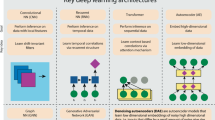Abstract
The expanding scale and inherent complexity of biological data have encouraged a growing use of machine learning in biology to build informative and predictive models of the underlying biological processes. All machine learning techniques fit models to data; however, the specific methods are quite varied and can at first glance seem bewildering. In this Review, we aim to provide readers with a gentle introduction to a few key machine learning techniques, including the most recently developed and widely used techniques involving deep neural networks. We describe how different techniques may be suited to specific types of biological data, and also discuss some best practices and points to consider when one is embarking on experiments involving machine learning. Some emerging directions in machine learning methodology are also discussed.
This is a preview of subscription content, access via your institution
Access options
Access Nature and 54 other Nature Portfolio journals
Get Nature+, our best-value online-access subscription
$29.99 / 30 days
cancel any time
Subscribe to this journal
Receive 12 print issues and online access
$189.00 per year
only $15.75 per issue
Buy this article
- Purchase on Springer Link
- Instant access to full article PDF
Prices may be subject to local taxes which are calculated during checkout
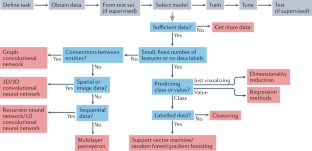
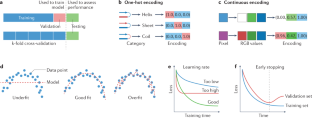
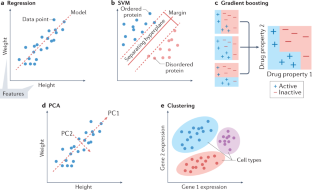
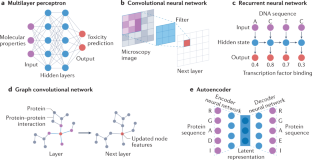
Similar content being viewed by others
References
Ching, T. et al. Opportunities and obstacles for deep learning in biology and medicine. J. R. Soc. Interface 15, 20170387 (2018). This is a thorough review of applications of deep learning to biology and medicine including many references to the literature.
Mitchell, T. M. Machine Learning (McGraw Hill, 1997).
Goodfellow, I., Bengio Y. & Courville, A. Deep Learning (MIT Press, 2016).
Libbrecht, M. W. & Noble, W. S. Machine learning applications in genetics and genomics. Nat. Rev. Genet. 16, 321–332 (2015).
Zou, J. et al. A primer on deep learning in genomics. Nat. Genet. 51, 12–18 (2019).
Myszczynska, M. A. et al. Applications of machine learning to diagnosis and treatment of neurodegenerative diseases. Nat. Rev. Neurol. 16, 440–456 (2020).
Yang, K. K., Wu, Z. & Arnold, F. H. Machine-learning-guided directed evolution for protein engineering. Nat. Methods 16, 687–694 (2019).
Tarca, A. L., Carey, V. J., Chen, X.-W., Romero, R. & Drăghici, S. Machine learning and its applications to biology. PLoS Comput. Biol. 3, e116 (2007). This is an introduction to machine learning concepts and applications in biology with a focus on traditional machine learning methods.
Silva, J. C. F., Teixeira, R. M., Silva, F. F., Brommonschenkel, S. H. & Fontes, E. P. B. Machine learning approaches and their current application in plant molecular biology: a systematic review. Plant. Sci. 284, 37–47 (2019).
Kandoi, G., Acencio, M. L. & Lemke, N. Prediction of druggable proteins using machine learning and systems biology: a mini-review. Front. Physiol. 6, 366 (2015).
Marblestone, A. H., Wayne, G. & Kording, K. P. Toward an integration of deep learning and neuroscience. Front. Comput. Neurosci. 10, 94 (2016).
Jiménez-Luna, J., Grisoni, F. & Schneider, G. Drug discovery with explainable artificial intelligence. Nat. Mach. Intell. 2, 573–584 (2020).
Buchan, D. W. A. & Jones, D. T. The PSIPRED Protein Analysis Workbench: 20 years on. Nucleic Acids Res. 47, W402–W407 (2019).
Kelley, D. R., Snoek, J. & Rinn, J. L. Basset: learning the regulatory code of the accessible genome with deep convolutional neural networks. Genome Res. 26, 990–999 (2016).
Altman, N. & Krzywinski, M. Clustering. Nat. Methods 14, 545–546 (2017).
Hopf, T. A. et al. Mutation effects predicted from sequence co-variation. Nat. Biotechnol. 35, 128–135 (2017).
Zhang, Z. et al. Predicting folding free energy changes upon single point mutations. Bioinformatics 28, 664–671 (2012).
Pedregosa, F. et al. Scikit-learn: machine learning in python. J. Mach. Learn. Res. 12, 2825–2830 (2011).
Kuhn, M. Building predictive models in r using the caret package. J. Stat. Softw. 28, 1–26 (2008).
Blaom, A. D. et al. MLJ: a Julia package for composable machine learning. J. Open Source Softw. 5, 2704 (2020).
Jones, D. T. Setting the standards for machine learning in biology. Nat. Rev. Mol. Cell Biol. 20, 659–660 (2019).
Alipanahi, B., Delong, A., Weirauch, M. T. & Frey, B. J. Predicting the sequence specificities of DNA- and RNA-binding proteins by deep learning. Nat. Biotechnol. 33, 831–838 (2015).
Senior, A. W. et al. Improved protein structure prediction using potentials from deep learning. Nature 577, 706–710 (2020). Technology company DeepMind entered the CASP13 assessment in protein structure prediction and its method using deep learning was the most accurate of the methods entered.
Esteva, A. et al. Dermatologist-level classification of skin cancer with deep neural networks. Nature 542, 115–118 (2017).
Tegunov, D. & Cramer, P. Real-time cryo-electron microscopy data preprocessing with Warp. Nat. Methods 16, 1146–1152 (2019).
LeCun, Y., Bengio, Y. & Hinton, G. Deep learning. Nature 521, 436–444 (2015). This is a review of deep learning by some of the major figures in the deep learning revolution.
Hastie T., Tibshirani R., Friedman J. The elements of statistical learning: data mining, inference, and prediction. 2nd Edn. (Springer Science & Business Media; 2009).
Adebayo, J. et al. Sanity checks for saliency maps. NeurIPS https://arxiv.org/abs/1810.03292 (2018).
Gal, Y. & Ghahramani, Z. Dropout as a Bayesian approximation: representing model uncertainty in deep learning. ICML 48, 1050–1059 (2016).
Smith, A. M. et al. Standard machine learning approaches outperform deep representation learning on phenotype prediction from transcriptomics data. BMC Bioinformatics 21, 119 (2020).
Tibshirani, R. Regression shrinkage and selection via the lasso. J. R. Stat. Soc. Ser. B. 58, 267–288 (1996).
Zou, H. & Hastie, T. Regularization and variable selection via the elastic net. J. R. Stat. Soc. Ser. B. 67, 301–320 (2005).
Noble, W. S. What is a support vector machine? Nat. Biotechnol. 24, 1565–1567 (2006).
Ben-Hur, A. & Weston, J. A user’s guide to support vector machines. Methods Mol. Biol. 609, 223–239 (2010).
Ben-Hur, A., Ong, C. S., Sonnenburg, S., Schölkopf, B. & Rätsch, G. Support vector machines and kernels for computational biology. PLoS Comput. Biol. 4, e1000173 (2008). This is an introduction to SVMs with a focus on biological data and prediction tasks.
Kircher, M. et al. A general framework for estimating the relative pathogenicity of human genetic variants. Nat. Genet. 46, 310–315 (2014).
Driscoll, M. K. et al. Robust and automated detection of subcellular morphological motifs in 3D microscopy images. Nat. Methods 16, 1037–1044 (2019).
Bzdok, D., Krzywinski, M. & Altman, N. Machine learning: supervised methods. Nat. Methods 15, 5–6 (2018).
Wang, C. & Zhang, Y. Improving scoring-docking-screening powers of protein-ligand scoring functions using random forest. J. Comput. Chem. 38, 169–177 (2017).
Zeng, W., Wu, M. & Jiang, R. Prediction of enhancer-promoter interactions via natural language processing. BMC Genomics 19, 84 (2018).
Olson, R. S., Cava, W. L., Mustahsan, Z., Varik, A. & Moore, J. H. Data-driven advice for applying machine learning to bioinformatics problems. Pac. Symp. Biocomput. 23, 192–203 (2018).
Rappoport, N. & Shamir, R. Multi-omic and multi-view clustering algorithms: review and cancer benchmark. Nucleic Acids Res. 47, 1044 (2019).
Steinegger, M. & Söding, J. MMseqs2 enables sensitive protein sequence searching for the analysis of massive data sets. Nat. Biotechnol. 35, 1026–1028 (2017).
Jain, A. K. Data clustering: 50 years beyond K-means. Pattern Recognit. Lett. 31, 651–666 (2010).
Ester M., Kriegel H.-P., Sander J., Xu X. A density-based algorithm for discovering clusters in large spatial databases with noise. KDD‘96 Proc. Second Int. Conf. Knowl. Discov. Data Mining. 96, 226–231 (1996).
Nguyen, L. H. & Holmes, S. Ten quick tips for effective dimensionality reduction. PLoS Comput. Biol. 15, e1006907 (2019).
Moon, K. R. et al. Visualizing structure and transitions in high-dimensional biological data. Nat. Biotechnol. 37, 1482–1492 (2019).
van der Maaten, L. & Hinton, G. Visualizing data using t-SNE. J. Mach. Learn. Res. 9, 2579–2605 (2008).
Kobak, D. & Berens, P. The art of using t-SNE for single-cell transcriptomics. Nat. Commun. 10, 5416 (2019). This article provides a discussion and tips for using t-SNE as a dimensionality reduction technique on single-cell transcriptomics data.
Crick, F. The recent excitement about neural networks. Nature 337, 129–132 (1989).
Geirhos, R. et al. Shortcut learning in deep neural networks. Nat. Mach. Intell. 2, 665–673 (2020). This article discusses a common problem in deep learning called ‘shortcut learning’, where the model uses decision rules that do not transfer to real-world data.
Qian, N. & Sejnowski, T. J. Predicting the secondary structure of globular proteins using neural network models. J. Mol. Biol. 202, 865–884 (1988).
deFigueiredo, R. J. et al. Neural-network-based classification of cognitively normal, demented, Alzheimer disease and vascular dementia from single photon emission with computed tomography image data from brain. Proc. Natl Acad. Sci. USA 92, 5530–5534 (1995).
Mayr, A., Klambauer, G., Unterthiner, T. & Hochreiter, S. DeepTox: toxicity prediction using deep learning. Front. Environ. Sci. 3, 80 (2016).
Yang, J. et al. Improved protein structure prediction using predicted interresidue orientations. Proc. Natl Acad. Sci. USA 117, 1496–1503 (2020).
Xu, J., Mcpartlon, M. & Li, J. Improved protein structure prediction by deep learning irrespective of co-evolution information. Nat. Mach. Intell. 3, 601–609 (2021).
Poplin, R. et al. A universal SNP and small-indel variant caller using deep neural networks. Nat. Biotechnol. 36, 983–987 (2018).
Fudenberg, G., Kelley, D. R. & Pollard, K. S. Predicting 3D genome folding from DNA sequence with Akita. Nat. Methods 17, 1111–1117 (2020).
Zeng, H., Edwards, M. D., Liu, G. & Gifford, D. K. Convolutional neural network architectures for predicting DNA-protein binding. Bioinformatics 32, i121–i127 (2016).
Yao, R., Qian, J. & Huang, Q. Deep-learning with synthetic data enables automated picking of cryo-EM particle images of biological macromolecules. Bioinformatics 36, 1252–1259 (2020).
Si, D. et al. Deep learning to predict protein backbone structure from high-resolution cryo-EM density maps. Sci. Rep. 10, 4282 (2020).
Poplin, R. et al. Prediction of cardiovascular risk factors from retinal fundus photographs via deep learning. Nat. Biomed. Eng. 2, 158–164 (2018).
AlQuraishi, M. End-to-end differentiable learning of protein structure. Cell Syst. 8, 292–301.e3 (2019).
Heffernan, R., Yang, Y., Paliwal, K. & Zhou, Y. Capturing non-local interactions by long short-term memory bidirectional recurrent neural networks for improving prediction of protein secondary structure, backbone angles, contact numbers and solvent accessibility. Bioinformatics 33, 2842–2849 (2017).
Müller, A. T., Hiss, J. A. & Schneider, G. Recurrent neural network model for constructive peptide design. J. Chem. Inf. Model. 58, 472–479 (2018).
Choi, E., Bahadori, M. T., Schuetz, A., Stewart, W. F. & Sun, J. Doctor AI: predicting clinical events via recurrent neural networks. JMLR Workshop Conf. Proc. 56, 301–318 (2016).
Quang, D. & Xie, X. DanQ: a hybrid convolutional and recurrent deep neural network for quantifying the function of DNA sequences. Nucleic Acids Res. 44, e107 (2016).
Alley, E. C., Khimulya, G., Biswas, S., AlQuraishi, M. & Church, G. M. Unified rational protein engineering with sequence-based deep representation learning. Nat. Methods 16, 1315–1322 (2019).
Vaswani, A. et al. Attention is all you need. arXiv https://arxiv.org/abs/1706.03762 (2017).
Elnaggar, A. et al. ProtTrans: towards cracking the language of life’s code through self-supervised deep learning and high performance computing. arXiv https://arxiv.org/abs/2007.06225 (2020).
Jumper, J. et al. Highly accurate protein structure prediction with AlphaFold. Nature 596, 583–589 (2021).
Battaglia, P. W. et al. Relational inductive biases, deep learning, and graph networks. arXiv https://arxiv.org/abs/1806.01261 (2018).
Stokes, J. M. et al. A deep learning approach to antibiotic discovery. Cell 181, 475–483 (2020). In this work, a deep learning model predicts antibiotic activity, with one candidate showing broad-spectrum antibiotic activities in mice.
Gainza, P. et al. Deciphering interaction fingerprints from protein molecular surfaces using geometric deep learning. Nat. Methods 17, 184–192 (2020).
Strokach, A., Becerra, D., Corbi-Verge, C., Perez-Riba, A. & Kim, P. M. Fast and flexible protein design using deep graph neural networks. Cell Syst. 11, 402–411.e4 (2020).
Gligorijevic, V. et al. Structure-based function prediction using graph convolutional networks. Nat. Commun. 12, 3168 (2021).
Zitnik, M., Agrawal, M. & Leskovec, J. Modeling polypharmacy side effects with graph convolutional networks. Bioinformatics 34, i457–i466 (2018).
Veselkov, K. et al. HyperFoods: machine intelligent mapping of cancer-beating molecules in foods. Sci. Rep. 9, 9237 (2019).
Fey, M. & Lenssen, J. E. Fast graph representation learning with PyTorch geometric. arXiv https://arxiv.org/abs/1903.02428 (2019).
Zhavoronkov, A. et al. Deep learning enables rapid identification of potent DDR1 kinase inhibitors. Nat. Biotechnol. 37, 1038–1040 (2019).
Wang, Y. et al. Predicting DNA methylation state of CpG dinucleotide using genome topological features and deep networks. Sci. Rep. 6, 19598 (2016).
Linder, J., Bogard, N., Rosenberg, A. B. & Seelig, G. A generative neural network for maximizing fitness and diversity of synthetic DNA and protein sequences. Cell Syst. 11, 49–62.e16 (2020).
Greener, J. G., Moffat, L. & Jones, D. T. Design of metalloproteins and novel protein folds using variational autoencoders. Sci. Rep. 8, 16189 (2018).
Wang, J. et al. scGNN is a novel graph neural network framework for single-cell RNA-Seq analyses. Nat. Commun. 12, 1882 (2021).
Paszke, A. et al. PyTorch: an imperative style, high-performance deep learning library. Adv. Neural Inf. Process. Syst. 32, 8024–8035 (2019).
Abadi M. et al. Tensorflow: a system for large-scale machine learning. 12th USENIX Symposium on Operating Systems Design and Implementation. 265–283 (USENIX, 2016).
Wei, Q. & Dunbrack, R. L. Jr The role of balanced training and testing data sets for binary classifiers in bioinformatics. PLoS ONE 8, e67863 (2013).
Walsh, I., Pollastri, G. & Tosatto, S. C. E. Correct machine learning on protein sequences: a peer-reviewing perspective. Brief. Bioinform 17, 831–840 (2016). This article discusses how peer reviewers can assess machine learning methods in biology, and by extension how scientists can design and conduct such studies properly.
Schreiber, J., Singh, R., Bilmes, J. & Noble, W. S. A pitfall for machine learning methods aiming to predict across cell types. Genome Biol. 21, 282 (2020).
Chothia, C. & Lesk, A. M. The relation between the divergence of sequence and structure in proteins. EMBO J. 5, 823–826 (1986).
Söding, J. & Remmert, M. Protein sequence comparison and fold recognition: progress and good-practice benchmarking. Curr. Opin. Struct. Biol. 21, 404–411 (2011).
Steinegger, M. et al. HH-suite3 for fast remote homology detection and deep protein annotation. BMC Bioinformatics 20, 473 (2019).
Sillitoe, I. et al. CATH: expanding the horizons of structure-based functional annotations for genome sequences. Nucleic Acids Res. 47, D280–D284 (2019).
Cheng, H. et al. ECOD: an evolutionary classification of protein domains. PLoS Comput. Biol. 10, e1003926 (2014).
Li, Y. & Yang, J. Structural and sequence similarity makes a significant impact on machine-learning-based scoring functions for protein-ligand interactions. J. Chem. Inf. Model. 57, 1007–1012 (2017).
Zech, J. R. et al. Variable generalization performance of a deep learning model to detect pneumonia in chest radiographs: a cross-sectional study. PLoS Med. 15, e1002683 (2018).
Szegedy, C. et al. Intriguing properties of neural networks. arXiv https://arxiv.org/abs/1312.6199 (2014).
Hie, B., Cho, H. & Berger, B. Realizing private and practical pharmacological collaboration. Science 362, 347–350 (2018).
Beaulieu-Jones, B. K. et al. Privacy-preserving generative deep neural networks support clinical data sharing. Circ. Cardiovasc. Qual. Outcomes 12, e005122 (2019).
Konečný, J., Brendan McMahan, H., Ramage, D. & Richtárik, P. Federated optimization: distributed machine learning for on-device intelligence. arXiv https://arxiv.org/abs/1610.02527 (2016).
Pérez, A., Martínez-Rosell, G. & De Fabritiis, G. Simulations meet machine learning in structural biology. Curr. Opin. Struct. Biol. 49, 139–144 (2018).
Noé, F., Olsson, S., Köhler, J. & Wu, H. Boltzmann generators: sampling equilibrium states of many-body systems with deep learning. Science 365, 6457 (2019).
Shrikumar, A., Greenside, P. & Kundaje, A. Reverse-complement parameter sharing improves deep learning models for genomics. bioRxiv https://www.biorxiv.org/content/10.1101/103663v1 (2017).
Lopez, R., Gayoso, A. & Yosef, N. Enhancing scientific discoveries in molecular biology with deep generative models. Mol. Syst. Biol. 16, e9198 (2020).
Anishchenko, I., Chidyausiku, T. M., Ovchinnikov, S., Pellock, S. J. & Baker, D. De novo protein design by deep network hallucination. bioRxiv https://doi.org/10.1101/2020.07.22.211482 (2020).
Innes, M. et al. A differentiable programming system to bridge machine learning and scientific computing. arXiv https://arxiv.org/abs/1907.07587 (2019).
Ingraham J., Riesselman A. J., Sander C., Marks D. S. Learning protein structure with a differentiable simulator. ICLR https://openreview.net/forum?id=Byg3y3C9Km (2019).
Jumper, J. M., Faruk, N. F., Freed, K. F. & Sosnick, T. R. Trajectory-based training enables protein simulations with accurate folding and Boltzmann ensembles in cpu-hours. PLoS Comput. Biol. 14, e1006578 (2018).
Wang, Y., Fass, J. & Chodera, J. D. End-to-end differentiable molecular mechanics force field construction. arXiv http://arxiv.org/abs/2010.01196 (2020).
Bradbury, J. et al. JAX: composable transformations of Python+NumPy programs. GitHub http://github.com/google/jax (2018).
Chen, K. M., Cofer, E. M., Zhou, J. & Troyanskaya, O. G. Selene: a PyTorch-based deep learning library for sequence data. Nat. Methods 16, 315–318 (2019). This work provides a software library based on PyTorch providing functionality for biological sequences.
Kopp, W., Monti, R., Tamburrini, A., Ohler, U. & Akalin, A. Deep learning for genomics using Janggu. Nat. Commun. 11, 3488 (2020).
Schoenholz, S. S. & Cubuk, E. D. JAX, M.D.: end-to-end differentiable, hardware accelerated, molecular dynamics in pure Python. arXiv https://arxiv.org/abs/1912.04232 (2019).
Avsec, Ž. et al. The Kipoi repository accelerates community exchange and reuse of predictive models for genomics. Nat. Biotechnol. 37, 592–600 (2019).
Isensee, F., Jaeger, P. F., Kohl, S. A. A., Petersen, J. & Maier-Hein, K. H. nnU-Net: a self-configuring method for deep learning-based biomedical image segmentation. Nat Methods 18, 203–211 (2020).
Livesey, B. J. & Marsh, J. A. Using deep mutational scanning to benchmark variant effect predictors and identify disease mutations. Mol. Syst. Biol. 16, e9380 (2020).
AlQuraishi, M. ProteinNet: a standardized data set for machine learning of protein structure. BMC Bioinformatics 20, 311 (2019).
Townshend, R. J. L. et al. ATOM3D: tasks on molecules in three dimensions. arXiv https://arxiv.org/abs/2012.04035 (2020).
Rao, R. et al. Evaluating protein transfer learning with TAPE. Adv. Neural. Inf. Process. Syst. 32, 9689–9701 (2019).
Kryshtafovych, A., Schwede, T., Topf, M., Fidelis, K. & Moult, J. Critical assessment of methods of protein structure prediction (CASP) — round XIII. Proteins 87, 1011–1020 (2019).
Zhou, N. et al. The CAFA challenge reports improved protein function prediction and new functional annotations for hundreds of genes through experimental screens. Genome Biol. 20, 244 (2019).
Munro, D. & Singh, M. DeMaSk: a deep mutational scanning substitution matrix and its use for variant impact prediction. Bioinformatics 36, 5322–5329 (2020).
Haario, H. & Taavitsainen, V.-M. Combining soft and hard modelling in chemical kinetic models. Chemom. Intell. Lab. Syst. 44, 77–98 (1998).
Cozzetto, D., Minneci, F., Currant, H. & Jones, D. T. FFPred 3: feature-based function prediction for all gene ontology domains. Sci. Rep. 6, 31865 (2016).
Nugent, T. & Jones, D. T. Transmembrane protein topology prediction using support vector machines. BMC Bioinformatics 10, 159 (2009).
Bao, L., Zhou, M. & Cui, Y. nsSNPAnalyzer: identifying disease-associated nonsynonymous single nucleotide polymorphisms. Nucleic Acids Res. 33, W480–W482 (2005).
Li, W., Yin, Y., Quan, X. & Zhang, H. Gene expression value prediction based on XGBoost algorithm. Front. Genet. 10, 1077 (2019).
Zhang, Y. & Skolnick, J. SPICKER: a clustering approach to identify near-native protein folds. J. Comput. Chem. 30, 865–871 (2004).
Teodoro, M. L., Phillips, G. N. Jr & Kavraki, L. E. Understanding protein flexibility through dimensionality reduction. J. Comput. Biol. 10, 617–634 (2003).
Schlichtkrull, M. et al. Modeling relational data with graph convolutional networks. arXiv https://arxiv.org/abs/1703.06103 (2019).
Pandarinath, C. et al. Inferring single-trial neural population dynamics using sequential auto-encoders. Nat. Methods 15, 805–815 (2018).
Antczak, M., Michaelis, M. & Wass, M. N. Environmental conditions shape the nature of a minimal bacterial genome. Nat. Commun. 10, 3100 (2019).
Sun, T., Zhou, B., Lai, L. & Pei, J. Sequence-based prediction of protein protein interaction using a deep-learning algorithm. BMC Bioinformatics 18, 277 (2017).
Hiranuma, N. et al. Improved protein structure refinement guided by deep learning based accuracy estimation. Nat. Commun. 12, 1340 (2021).
Pagès, G., Charmettant, B. & Grudinin, S. Protein model quality assessment using 3D oriented convolutional neural networks. Bioinformatics 35, 3313–3319 (2019).
Pires, D. E. V., Ascher, D. B. & Blundell, T. L. DUET: a server for predicting effects of mutations on protein stability using an integrated computational approach. Nucleic Acids Res. 42, W314–W319 (2014).
Yuan, Y. & Bar-Joseph, Z. Deep learning for inferring gene relationships from single-cell expression data. Proc. Natl Acad. Sci. USA 116, 27151–27158 (2019).
Chen, L., Cai, C., Chen, V. & Lu, X. Learning a hierarchical representation of the yeast transcriptomic machinery using an autoencoder model. BMC Bioinformatics 17, S9 (2016).
Kantz, E. D., Tiwari, S., Watrous, J. D., Cheng, S. & Jain, M. Deep neural networks for classification of LC-MS spectral peaks. Anal. Chem. 91, 12407–12413 (2019).
Dührkop, K. et al. SIRIUS 4: a rapid tool for turning tandem mass spectra into metabolite structure information. Nat. Methods 16, 299–302 (2019).
Liebal, U. W., Phan, A. N. T., Sudhakar, M., Raman, K. & Blank, L. M. Machine learning applications for mass spectrometry-based metabolomics. Metabolites 10, 243 (2020).
Zhong, E. D., Bepler, T., Berger, B. & Davis, J. H. CryoDRGN: reconstruction of heterogeneous cryo-EM structures using neural networks. Nat. Methods 18, 176–185 (2021).
Schmauch, B. et al. A deep learning model to predict RNA-Seq expression of tumours from whole slide images. Nat. Commun. 11, 3877 (2020).
Das, P. et al. Accelerated antimicrobial discovery via deep generative models and molecular dynamics simulations. Nat. Biomed. Eng. 5, 613–623 (2021).
Gligorijevic, V., Barot, M. & Bonneau, R. deepNF: deep network fusion for protein function prediction. Bioinformatics 34, 3873–3881 (2018).
Karpathy A. A recipe for training neural networks. https://karpathy.github.io/2019/04/25/recipe (2019).
Bengio, Y. Practical recommendations for gradient-based training of deep architectures. Lecture Notes Comput. Sci. 7700, 437–478 (2012).
Roberts, M. et al. Common pitfalls and recommendations for using machine learning to detect and prognosticate for COVID-19 using chest radiographs and CT scans. Nat. Mach. Intell. 3, 199–217 (2021). This study assesses 62 machine learning studies that analyse medical images for COVID-19 and none is found to be of clinical use, indicating the difficulties of training a useful model.
List, M., Ebert, P. & Albrecht, F. Ten simple rules for developing usable software in computational biology. PLoS Comput. Biol. 13, e1005265 (2017).
Sonnenburg, S. Ã., Braun, M. L., Ong, C. S. & Bengio, S. The need for open source software in machine learning. J. Mach. Learn. Res. 8, 2443–2466 (2007).
Acknowledgements
The authors thank members of the UCL Bioinformatics Group for valuable discussions and comments. This work was supported by the European Research Council Advanced Grant ProCovar (project ID 695558).
Author information
Authors and Affiliations
Contributions
All authors researched data for the article, contributed substantially to discussion of the content, wrote the article and reviewed the manuscript before submission.
Corresponding author
Ethics declarations
Competing interests
The authors declare no competing interests.
Additional information
Peer review information
Nature Reviews Molecular Cell Biology thanks S. Draghici who co-reviewed with T. Nguyen; B. Chain; S. Haider; F. Mahmood; and the other, anonymous, reviewer(s) for their contribution to the peer review of this work.
Publisher’s note
Springer Nature remains neutral with regard to jurisdictional claims in published maps and institutional affiliations.
Related links
Caret: https://topepo.github.io/caret
Colaboratory: https://research.google.com/colaboratory
Graph Nets: https://github.com/deepmind/graph_nets
MLJ: https://alan-turing-institute.github.io/MLJ.jl/stable
PyTorch: https://pytorch.org
PyTorch Geometric: https://pytorch-geometric.readthedocs.io/en/latest
scikit-learn: https://scikit-learn.org/stable
Tensorflow: https://www.tensorflow.org
Glossary
- Deep learning
-
Machine learning methods based on neural networks. The adjective ‘deep’ refers to the use of many hidden layers in the network, two hidden layers as a minimum but usually many more than that. Deep learning is a subset of machine learning, and hence of artificial intelligence more broadly.
- Artificial neural networks
-
A collection of connected nodes loosely representing neuron connectivity in a biological brain. Each node is part of a layer and represents a number calculated from the previous layer. The connections, or edges, allow a signal to flow from the input layer to the output layer via hidden layers.
- Ground truth
-
The true value that the output of a machine learning model is compared with to train the model and test performance. These data usually come from experimental data (for example, accessibility of a region of DNA to transcription factors) or expert human annotation (for example healthy or pathological medical image).
- Encoding
-
Any scheme for numerically representing (often categorical) data in a form suitable for use in a machine learning model. An encoding can be a fixed numerical representation (for example, one-hot or continuous encoding) or can be defined using parameters that are trained along with the rest of a model.
- One-hot encoding
-
An encoding scheme that represents a fixed set of n categorical inputs using n unique n-dimensional vectors, each with one element set to 1 and the rest set to 0. For example, the set of three letters (A,B,C) could be represented by the three vectors [1,0,0], [0,1,0] and [0,0,1], respectively.
- Mean squared error
-
A loss function that calculates the average squared difference between the predicted values and the ground truth. This function heavily penalizes outliers because it increases rapidly as the difference between a predicted value and the ground truth grows.
- Binary cross entropy
-
The most common loss function for training a binary classifier; that is, for tasks aimed at answering a question with only two choices (such as cancer versus non-cancer); sometimes called ‘log loss’.
- Linear regression
-
A model that assumes that the output can be calculated from a linear combination of inputs; that is, each input feature is multiplied by a single parameter and these values are added. It is easy to interpret how these models make their predictions.
- Kernel functions
-
Transformations applied to each data point to map the original points into a space in which they become separable with respect to their class.
- Non-linear regression
-
A model where the output is calculated from a non-linear combination of inputs; that is, the input features can be combined during prediction using operations such as multiplication. These models can describe more complex phenomena than linear regression.
- k nearest neighbours
-
A classification approach where a data point is classified on the basis of the known (ground truth) classes of the k most similar points in the training set using a majority voting rule. k is a parameter that can be tuned. Can also be used for regression by averaging the property value over the k nearest neighbours.
- Regularization
-
Restricting the values of parameters to prevent the model from overfitting to the training data. For example, penalizing high parameter values in regression models reduces the flexibility of the model and can stop it fitting to noise in the training data.
- Cloud computing
-
On-demand computing services, including processing power and data storage, typically available via the Internet. A pay-as-you-go model is usually used. Use of cloud computing minimizes up-front IT infrastructure costs.
- Hidden Markov model
-
A statistical model that can be used to describe the evolution of observable events that depend on factors that are not directly observable. It has various uses in biology, including representing protein sequence families.
- Saliency map
-
In the context of machine learning, an image generated to show which pixels in an input image contribute to the prediction made by a model. It is useful in interpreting models.
- Automatic differentiation
-
A set of techniques to automatically calculate the gradient of a function in a computer program. Used to train neural networks, where it is called ‘backpropagation’.
- Gradients
-
The rate of change of one property as another property changes. In neural networks, the set of gradients of the loss function with respect to the neural network parameters, computed via a process known as backpropagation, is used to adjust the parameters and thus train the model.
Rights and permissions
About this article
Cite this article
Greener, J.G., Kandathil, S.M., Moffat, L. et al. A guide to machine learning for biologists. Nat Rev Mol Cell Biol 23, 40–55 (2022). https://doi.org/10.1038/s41580-021-00407-0
Accepted:
Published:
Issue Date:
DOI: https://doi.org/10.1038/s41580-021-00407-0
This article is cited by
-
Comprehensive analysis of mitochondria-related genes indicates that PPP2R2B is a novel biomarker and promotes the progression of bladder cancer via Wnt signaling pathway
Biology Direct (2024)
-
Antimicrobial resistance crisis: could artificial intelligence be the solution?
Military Medical Research (2024)
-
Machine learning-based integration identifies the ferroptosis hub genes in nonalcoholic steatohepatitis
Lipids in Health and Disease (2024)
-
Development and validation of a machine learning-based predictive model for assessing the 90-day prognostic outcome of patients with spontaneous intracerebral hemorrhage
Journal of Translational Medicine (2024)
-
Development and validation of a deep learning model for predicting postoperative survival of patients with gastric cancer
BMC Public Health (2024)

